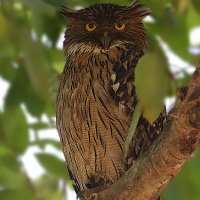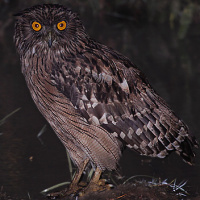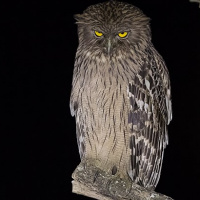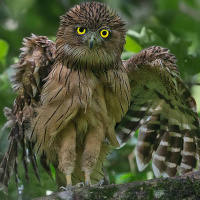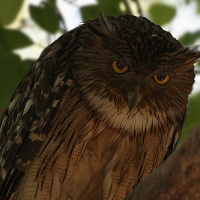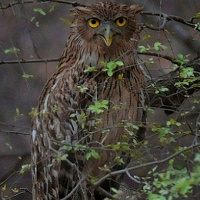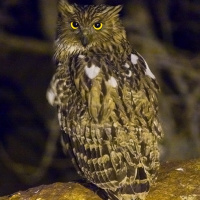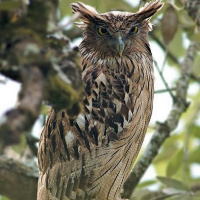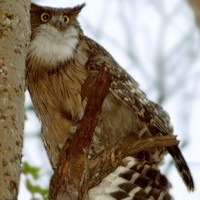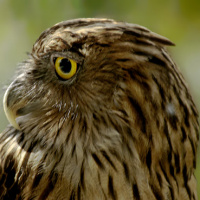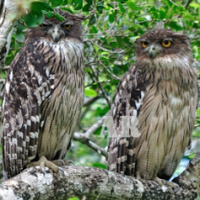Introduction
The Brown Fish Owl is a fairly large owl with tousled, horizontally oriented ear-tufts and long legs.
Photo Gallery (14 pictures)
Sound Gallery
Information
Description: The indistinct facial disc is tawny, with black shaft-streaks on individual feathers. Eyes are golden yellow, while the bill is
pale greenish-grey, and dusky on the upper ridge and tip. Ear-tufts are bushy and tousled.
Upperparts are pale chestnut-brown with broad, black shaft-streaks and brown cross-bars. The lower back, rump and uppertail-coverts are paler and have narrow
shaft-streaks. The scapulars, tertial feathers and wing-coverts are mottled with whitish, with the outer webs of the outer scapulars white. Flight and tail
feathers are dark brown, barred, vermiculated and tipped dusky-buff. The throat and foreneck are prominently white with dark shaft-streaks.
Underparts are pale fulvous with fine, wavy pale brown to rufous cross-bars and bold black shaft-streaks.
Tarsi and toes are bare, coloured dusky to greyish yellow, and covered with granular scales. The soles of the toes have pointed scales to assist with
gripping fish. Claws are horn-brown.
Size: Length 48-58cm. Wing length 355-434mm. Tail length 175-214mm. Weight 1105-1308g. Females are often larger and heavier than males.
Habits: The Brown Fish Owl is semi-diurnal, roosting in large trees during the daytime and leaving well before sunset. They can often be seen in daylight, sometimes hunting, especially on cloudy days. They bathe frequently by wading into the shallows and ruffling their feathers before drying and carefully preening the plumage.
Voice: The call of the male is a deep "tu-whoo-hu" lasting 1.5-2 seconds with the first and third note often higher in pitch. This is repeated at intervals of several seconds. This song is often answered by his mate with an ascending "oo" or a similar song to the male. There is also a deep, hollow "boom-boom" or "Boom-o-boom" call with a reverberating, ventriloquial quality, repeated at intervals.
Hunting & Food: Brown Fish Owls feed mainly on fish, frogs and crabs, but will also take rodents, birds, reptiles and large beetles. Hunts by watching for prey from a perch overlooking water - such as a stump or rock on the edge or in the middle of a stream. They will often fly up and down, sometimes almost skimming the water. Fish are scooped up from near the surface.
Breeding: Breeding season is generally from November to March, mainly January and February, but as late as April in Sri Lanka. They will breed in abandoned stick nests of large birds, or a rock ledge near water or cleft of a rocky bank, or ruins of an old building. They may also nest in the cradle in a fork of a mature tree, such as mango or fig. The female lays one or two roundish, smooth white eggs averaging 58.4 x 48.9 mm.
Habitat: The Brown Fish Owl is generally found in thick lowland forest and open but well-wooded country, always near water. They can also be found in old mango groves or plantations, or even roadside and canalside avenues and densely leafy trees along streams and tanks, or overgrown eroded ravines and steep river banks. May be found near human habitations. Ranges from lowlands up to about 1800m elevation.
Distribution: Northwest Pakistan through the Himalayas and Nepal, south through India, Sri Lanka, west to southern China down to the Malay peninsula.
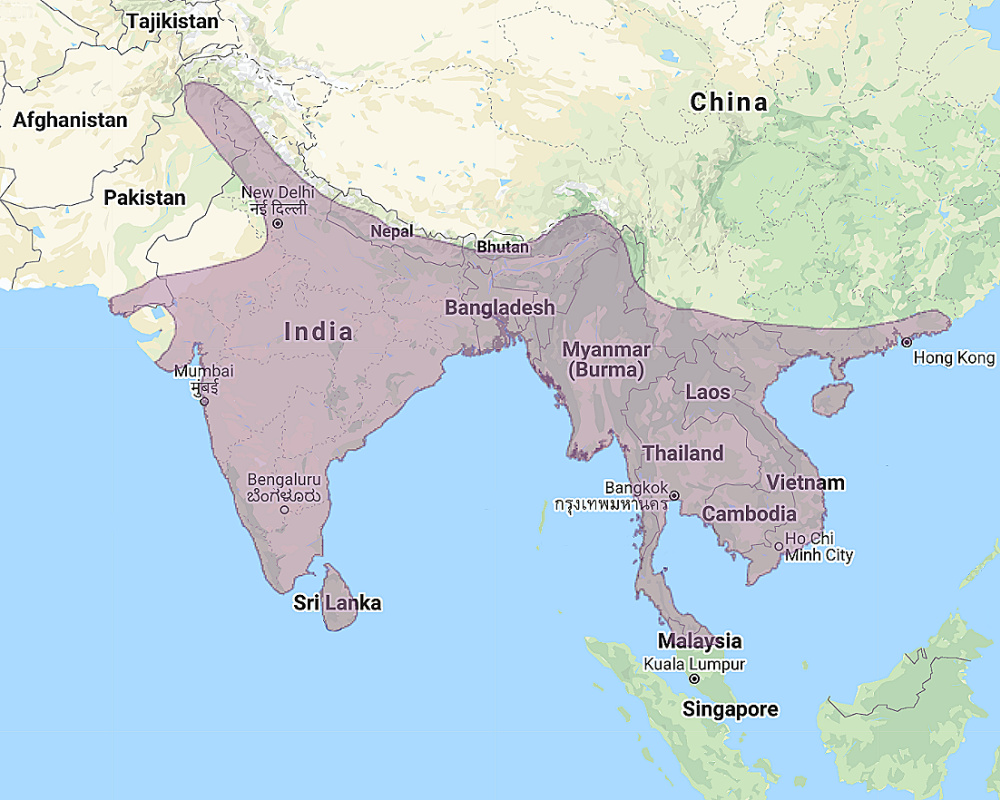
Range of the Brown Fish Owl Ketupa zeylonensis
Status: Generally uncommon, but common in Sri Lanka.
Original Description: Gmelin, Johann Freidrich. 1788. Systema Naturae (Syst. Nat.) 1: pt.1 p. 287.

